Related Research Articles

The Boeing RC-135 is a family of large reconnaissance aircraft built by Boeing and modified by a number of companies, including General Dynamics, Lockheed, LTV, E-Systems, and L3 Technologies, and used by the United States Air Force and Royal Air Force to support theater and national level intelligence consumers with near real-time on-scene collection, analysis and dissemination capabilities.

Strategic Air Command (SAC) was both a United States Department of Defense (DoD) Specified Command and a United States Air Force (USAF) Major Command (MAJCOM), responsible for Cold War command and control of two of the three components of the U.S. military's strategic nuclear strike forces, the so-called "nuclear triad", with SAC having control of land-based strategic bomber aircraft and intercontinental ballistic missiles or ICBMs.

Loring Air Force Base was a United States Air Force installation in northeastern Maine, near Limestone and Caribou in Aroostook County. It was one of the largest bases of the U.S. Air Force's Strategic Air Command during its existence, and was transferred to the newly created Air Combat Command in 1992.

Offutt Air Force Base is a U.S. Air Force base south of Omaha, adjacent to Bellevue in Sarpy County, Nebraska. It is the headquarters of the U.S. Strategic Command (USSTRATCOM), the 557th Weather Wing, and the 55th Wing of the Air Combat Command (ACC), the latter serving as the host unit.

The Vickers Valiant was a British high-altitude jet bomber designed to carry nuclear weapons, and in the 1950s and 1960s was part of the Royal Air Force's "V bomber" strategic deterrent force. It was developed by Vickers-Armstrongs in response to Specification B.35/46 issued by the Air Ministry for a nuclear-armed jet-powered bomber. The Valiant was the first of the V bombers to become operational, and was followed by the Handley Page Victor and the Avro Vulcan. The Valiant was the only V bomber to have dropped live nuclear weapons.

The Boeing E-4 Advanced Airborne Command Post (AACP), the current "Nightwatch" aircraft, is a strategic command and control military aircraft operated by the United States Air Force (USAF). The E-4 series are specially modified from the Boeing 747-200B for the National Emergency Airborne Command Post (NEACP) program. The E-4 serves as a survivable mobile command post for the National Command Authority, namely the President of the United States, the Secretary of Defense, and successors. The four E-4Bs are operated by the 1st Airborne Command and Control Squadron of the 595th Command and Control Group located at Offutt Air Force Base, near Omaha, Nebraska. An E-4B when in action is denoted a "National Airborne Operations Center".
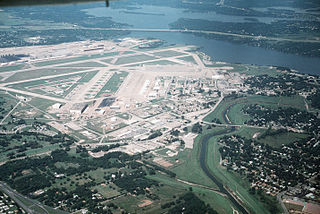
Naval Air Station Fort Worth Joint Reserve Base includes Carswell Field, a military airbase located 5 nautical miles west of the central business district of Fort Worth, in Tarrant County, Texas, United States. This military airfield is operated by the United States Navy Reserve. It is located in the cities of Fort Worth, Westworth Village, and White Settlement in the western part of the Fort Worth urban area.

Carswell Air Force Base is a former United States Air Force (USAF) base, located northwest of Fort Worth, Texas. For most of its operational lifetime, the base's mission was to train and support heavy strategic bombing groups and wings.
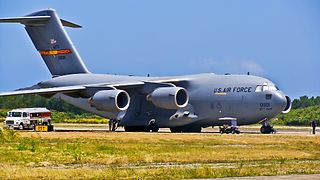
The 97th Air Mobility Wing is a United States Air Force (USAF) unit assigned to Nineteenth Air Force of Air Education and Training Command. It is stationed at Altus Air Force Base, Oklahoma. The wing is also the host unit at Altus. It plans and executes McDonnell Douglas C-17 Globemaster III, Boeing KC-46, and Boeing KC-135 Stratotanker pilot and aircrew training, providing formal school initial and advanced specialty training programs for up to 3,000 students annually. The training is done in a three-phase approach: Academic Phase, Simulator Phase, and Flying Phase.
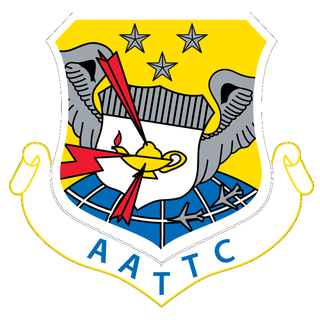
The Advanced Airlift Tactics Training Center, (AATTC), is located at Rosecrans Air National Guard Base, Saint Joseph, Missouri. The host unit is the 139th Airlift Wing, Missouri Air National Guard. Founded in 1983, the AATTC was the brainchild of Major Howard W. Dixon, a pilot who sought the need to establish low level combat survival training and maneuvers for C-130 aircrews; as well as the airlift community as a whole. This evasive aerial survival training had been exclusive to the fighter community up until the establishment of the AATTC, which would expand this training to C-130 aircrews. The school would continue to evolve with the combined efforts of the technicians, AGR's and members of the 180th Airlift Squadron.

The United States Air Force's 6th Air Refueling Wing is the host wing for MacDill Air Force Base, Florida. It is part of Air Mobility Command's (AMC) Eighteenth Air Force. The wing's 6th Operations Group is a successor organization of the 3d Observation Group, one of the seven original combat air groups formed by the United States Army Air Service shortly after the end of World War I.
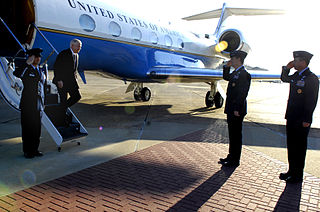
The 42nd Air Base Wing is a United States Air Force unit assigned to Air University of Air Education and Training Command. It is stationed at Maxwell-Gunter Air Force Base, Alabama and is the host unit for Maxwell-Gunter. The wing's primary mission is to support all activities of Air University, the 908th Airlift Wing and other tenant units stationed at Maxwell-Gunter.
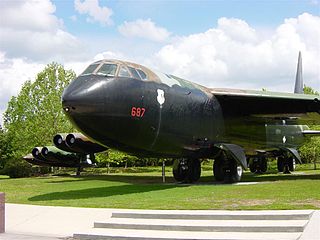
The 306th Strategic Wing, previously the 306th Bombardment Wing, is an inactive United States Air Force unit. It was last assigned to the Strategic Air Command at RAF Mildenhall, England and was inactivated on 1 February 1992. Its heritage as both the 306th Bombardment Wing and its predecessor organization, the 306th Bombardment Group of World War II, was assumed by the 306th Flying Training Group, an Air Education and Training Command organization at the United States Air Force Academy, Colorado.

The Boeing B-52 Stratofortress is an American long-range, subsonic, jet-powered strategic bomber. The B-52 was designed and built by Boeing, which has continued to provide support and upgrades. It has been operated by the United States Air Force (USAF) since the 1950s. The bomber is capable of carrying up to 70,000 pounds (32,000 kg) of weapons, and has a typical combat range of more than 8,800 miles (14,080 km) without aerial refueling.

The 92nd Air Refueling Squadron, sometimes written as 92d Air Refueling Squadron, is a squadron of the 92nd Air Refueling Wing's 92nd Operations Group, stationed at Fairchild Air Force Base, Washington. It was first activated shortly before the entry of the United States into World War II as the 2nd Reconnaissance Squadron. After training in the Douglas B-18 Bolo in the southeastern United States, the squadron moved to the Pacific Coast after the Japanese attack on Pearl Harbor and participated in antisubmarine patrols with the Consolidated B-24 Liberator. In April 1942, it was redesignated the 392nd Bombardment Squadron. Starting in mid-1942, it also began training crews on the Liberator. It ended these operations in July 1943 and began to prepare for overseas movement. After three months of training, the squadron moved to the Central Pacific, where it flew its first combat mission in November. The 392nd continued combat operations until March 1945, when it was withdrawn and moved to Hawaii, where it conducted routine training and patrol operations until it was inactivated in November 1945.

Operation Chrome Dome was a United States Air Force Cold War-era mission from 1960 to 1968 in which B-52 strategic bomber aircraft armed with thermonuclear weapons remained on continuous airborne alert and flew routes to points on the Soviet Union's border.
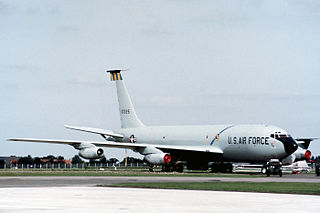
The 42d Air Refueling Squadron is an inactive United States Air Force unit. It was last assigned to the 42d Bombardment Wing at Loring Air Force Base, Maine, where it was inactivated on 30 April 1994.

A minimum interval takeoff (MITO) is a technique of the United States Air Force for scrambling all available bomber and tanker aircraft at twelve- and fifteen-second intervals, respectively. Before takeoff, the aircraft perform an elephant walk to the runway. It is designed to maximize the number of aircraft launched in the least amount of time possible before the base suffers a nuclear strike, which would obliterate all remaining aircraft.
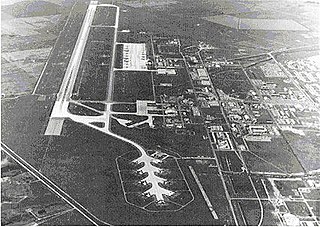
A "Christmas tree" was a type of alert area constructed by the United States Air Force for the Strategic Air Command (SAC) during the Cold War. Oftentimes, bombers or tanker aircraft were stationed next to a readiness crew building (RCB), also known as "mole hole" facilities. The alert apron, also known as an alert ramp, received the name "Christmas tree", because in planform it resembled a tree of the same name.
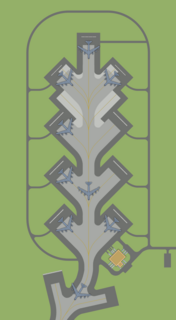
A mole hole, officially designated the Readiness Crew Building (RCB), is a type of structure built by the United States Air Force at former Strategic Air Command (SAC) bases around the country during the 1950s and 1960s. RCBs were located adjacent to an Alert Ramp, also called a "Christmas Tree", where Ready Alert aircraft were parked. These aircraft were initially Boeing B-47 Stratojet aircraft armed with nuclear weapons, augmented by Boeing KC-97 Stratofreighter aerial refueling aircraft. As SAC introduced newer bomber and aerial tanker aircraft into its inventory, the B-47 and KC-97 were later superseded by Boeing B-52 Stratofortress, Convair B-58 Hustler, General Dynamics FB-111 or Rockwell B-1 Lancer bombers, augmented by Boeing KC-135 Stratotanker or McDonnell Douglas KC-10 Extender aerial refueling aircraft.
References
- 1 2 Strategic Air Command. The SAC Alert Program 1956-1959 (Historical Study No. 79) (PDF). Offutt Air Force Base, Nebraska: United States Air Force.
- ↑ "The Air Force versus Hollywood". George Washington University . Retrieved 6 May 2012.
- 1 2 3 4 5 42d Bombardment Wing (1959). Operation Headstart (Film reel). Loring Air Force Base, Maine: United States Air Force.[ dead YouTube link ]